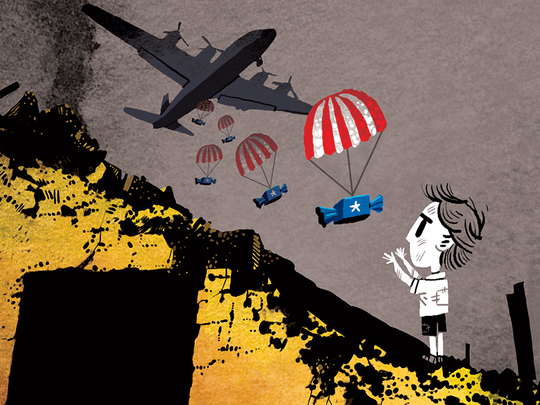
In the wake of a Group of Seven summit that saw the United States stiff-arm its allies and call for an embrace of Vladimir Putin’s Russia, it is fair to say that the idea of a unified front of internationalist democracies is, if not dead, at least in deep hibernation. It was the latest sign that the West, at least as we know it today, is faltering, 70 years after it was born in Berlin.
Seventy years ago this month, a crisis in the centre of Europe brought the United States and Russia face to face as adversaries for the first time. There was no clear sense how an America still finding its footing after the Second World War would respond. But there in Berlin, America chose a path of international leadership backed by armed strength and a humanitarian purpose. This choice bound the United States to Western Europe and brought together an economic and military alliance that has shaped much of the past century of world history. And it showed how Central America’s moral leadership was to the vitality and stability of the Western alliance.
At 6am on June 24, 1948, the Soviet Union commenced a blockade of the American, French and British-controlled sectors of Berlin. Over 2 million people, living amid the ruins of German leader Adolf Hitler’s capital and surrounded in all directions by Soviet-controlled territory, were cut off from all the food, fuel and supplies they needed to survive.
It was the Soviet Union’s next step in a campaign to dominate Europe. In the preceding year, Russian pressure and subterfuge had toppled the burgeoning democratic governments of the newly liberated countries of Eastern Europe and replaced them with communist puppet regimes. Now western Berlin was the next place under threat as the Red tide moved west. But rather than facing small, war-ravaged nations like Hungary and Czechoslovakia, the Soviets confronted their former Second World War allies and fellow occupiers of Germany’s divided capital.
How would America respond to this challenge? No one knew for sure. In the three years since the Second World War had ended, the United States had begun to return to its pre-war pattern of global solitude. Secretary of State George Marshall had proposed a plan to rebuild Europe in May 1947, but Congress — buffeted by the Soviet-friendly views of former Vice-President Henry Wallace’s acolytes on the left and isolationist Republican leader Robert Taft’s followers on the right — delayed hearings for seven months, then passed the plan without appropriating any funds in March 1948. At the same time, the Truman administration rebuffed entreaties from Great Britain, France and the Low Countries for the United States to formally guarantee it would defend them from a Soviet attack.
America’s retreat left a void of confidence in Europe. In western Germany, political leaders were reluctant to move forward with the idea of establishing their own nation because they doubted the Americans would stay and fight when the inevitable Soviet response came. In France and Italy, communist parties were making great gains in national elections.
On that June morning 70 years ago, the situation in Berlin offered little to tempt Americans from their retrenchment. The Soviet blockade seemed to leave Truman administration officials with only three bad options. They could stand by while rations ran out and the people of Berlin, almost all of whom were women and children, starved to death before the eyes of the world. They could retreat from Berlin, ending the blockade and saving the Berliners from starvation. But such a flight would likely have resulted in the fall of the rest of Germany and much of Western Europe to the Russians.
Or they could launch an armed response. But despite the handful of crude atomic bombs in America’s arsenal, the United States and Western Europe were ill-prepared for another war. The Soviet military outnumbered them 62 to 1 in Germany, and the American Air Force in Europe consisted of only 275 planes.
But a fourth option emerged: an airlift. And it worked. A makeshift airlift of supplies to the western sectors of the city grew from just a handful of flights per day to an enormous humanitarian option with planes landing and taking off every 90 seconds, 24 hours a day. It grew beyond anyone’s original expectations, delivering just enough to keep Berliners alive.
While the food and fuel were vital, they weren’t the only aspects of the airlift that mattered. Hungry, fearful Berliners would likely have folded to Soviet inducements and threats had America supplied only their material needs. Berliners were moved by the sight of American pilots — only recently their enemies during the Second World War — now risking their lives and even occasionally dropping tiny parachutes bearing chocolate for children. And they were inspired by an America that not only resisted the Soviets, but also embraced a vision for a free world and acted on it.
Berliners, and then people across Western Europe, responded to these ideals by resisting Soviet calls to rise up against the Western occupiers to end the siege. “I walked proudly through the streets,” one Berliner remembered a few years after the blockade. “I was helping to write a proud page in the history of Berlin’s housewives.”
American leadership gave others the confidence to step forward as well. The United States signed the North Atlantic Treaty in March 1949, binding it to the defence of Western democracies. German leaders, now confident in America’s lasting power on the world stage, signed the constitution creating the new, democratic nation of West Germany the same week as the Berlin blockade was lifted that May.
Much like the winter at Valley Forge or the bus boycott in Montgomery, the Berlin blockade and airlift were a crucible of crisis and a foundational moment for what came after. The United States and the nations of Western Europe were brought together by a common threat that made clear their shared values and by a mutual commitment to liberal democracy and open markets. What the airlift showed was that America’s military and economic strength was not enough to make it a global leader. It also needed moral power, one that its pilots demonstrated in the skies over Germany 70 years ago.
— Washington Post
Andrei Cherny is the author of The Candy Bombers: The Untold Story of the Berlin Airlift and America’s Finest Hour.










